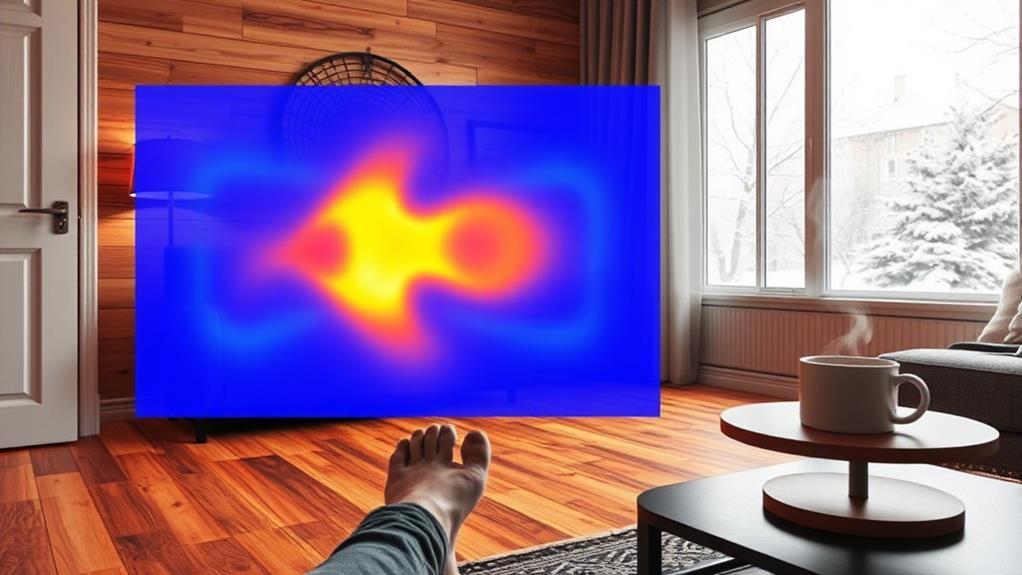Radiant floor heating offers a luxurious and efficient way to warm your home. It works by circulating heat through pipes or electric mats beneath your flooring, creating consistent warmth from the ground up. You'll enjoy even heat distribution, improved air quality, and potential energy savings of up to 30% compared to traditional forced-air systems. While installation costs are higher, long-term benefits include lower energy bills, minimal maintenance, and increased home value. With options for various flooring types and eco-friendly configurations, radiant heating combines comfort with sustainability. Discover how this innovative system can transform your living space and heating experience.
How Radiant Floor Heating Works
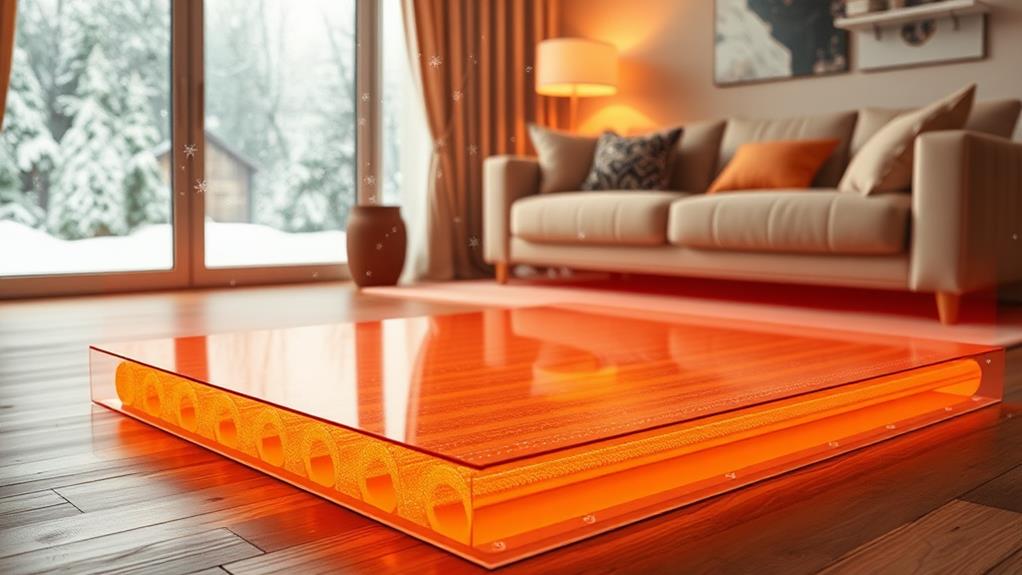
Radiant floor heating operates on a simple yet effective principle. It involves installing a heating system beneath your floor that radiates warmth upward, creating a comfortable living space. Unlike traditional forced-air systems, radiant heating doesn't rely on blowing hot air through vents.
There are two main types of radiant floor heating: electric and hydronic. Electric systems use resistance wires or heating mats placed under the flooring. When electricity flows through these elements, they generate heat that's transferred to the floor surface. Hydronic systems, on the other hand, circulate hot water through a network of pipes beneath the floor.
The heat from these systems warms the floor directly, which then radiates that warmth into the room. This method of heating is highly efficient because it doesn't lose heat through ductwork, and it provides consistent warmth from the ground up. You'll feel the warmth on your feet first, creating a cozy atmosphere throughout the space. Radiant floor heating can be installed under various flooring materials, including tile, hardwood, and even carpeting, making it a versatile option for many homes.
Types of Radiant Floor Systems
Understanding the different types of radiant floor systems can help you choose the best option for your home. There are three main types: electric, hydronic, and air-heated systems.
Electric radiant floors use electric cables or mats embedded in the floor. They're ideal for small areas like bathrooms or kitchens. Installation is relatively simple, and you can control them with a thermostat. However, they can be expensive to operate in large spaces due to electricity costs.
Hydronic systems, the most popular and cost-effective for whole-house heating, use hot water pumped through tubing under the floor. They're energy-efficient and work well with various heat sources, including boilers, water heaters, or solar water heating systems.
Air-heated radiant floors are the least common. They pump heated air through the floor but aren't very efficient for residential use due to air's limited capacity to hold heat.
Each system has its pros and cons. Electric systems offer easy installation and zoned heating. Hydronic systems provide efficient whole-house heating. Air systems, while less common, might suit specific applications. Consider factors like installation costs, energy efficiency, and your home's layout when choosing a radiant floor system.
Energy Efficiency and Cost Savings
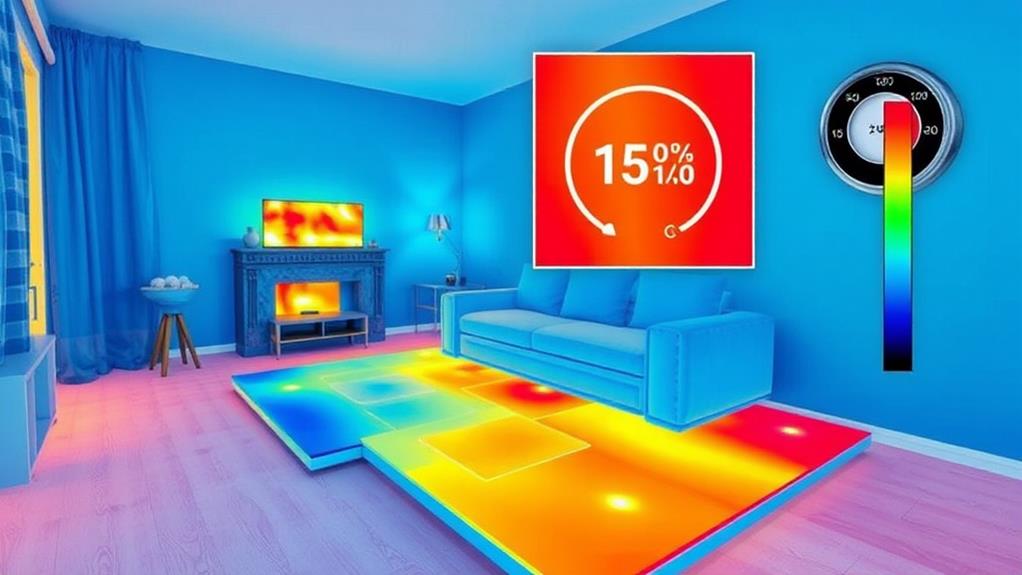
Over time, homeowners are increasingly turning to radiant floor heating for its energy efficiency and potential cost savings. You'll find that radiant systems can be up to 30% more efficient than traditional forced-air heating, as they don't lose heat through ductwork. This efficiency translates to lower energy bills and reduced environmental impact.
Radiant floor heating allows you to maintain comfort at lower thermostat settings. Since the heat rises evenly from the floor, you'll feel warmer at lower air temperatures. This can lead to energy savings of 10-20% compared to other heating methods.
You'll also benefit from zoned heating capabilities. By controlling different areas independently, you can heat only the rooms you're using, further reducing energy consumption.
The initial installation cost of radiant floor heating is higher than traditional systems. However, you'll recoup this investment through long-term energy savings and increased home value. Maintenance costs are minimal, as there are no filters to replace or ductwork to clean.
Consider your local energy prices and climate when calculating potential savings. In areas with high heating costs or long winters, radiant floor heating can offer significant financial benefits over time.
Comfort and Health Benefits
Many homeowners find that radiant floor heating offers superior comfort and several health benefits compared to traditional heating systems. You'll experience even heat distribution throughout your home, eliminating cold spots and drafts common with forced-air systems. The gentle warmth rising from the floor creates a cozy atmosphere that's particularly pleasant on bare feet.
Unlike forced-air systems, radiant heating doesn't circulate dust, allergens, or other airborne particles. This can significantly improve indoor air quality, benefiting those with allergies or respiratory issues. The reduced air movement also helps maintain optimal humidity levels, preventing dry skin and nasal passages during winter months.
Radiant heat's silent operation contributes to a quieter living environment, reducing stress and promoting better sleep. The absence of blowing air also means fewer temperature fluctuations, which can help regulate your body temperature more effectively.
You'll also appreciate the increased usable space in your rooms, as there's no need for bulky radiators or vents. This design flexibility allows for more freedom in furniture placement and room layouts, enhancing your home's overall comfort and functionality.
Installation Process and Considerations
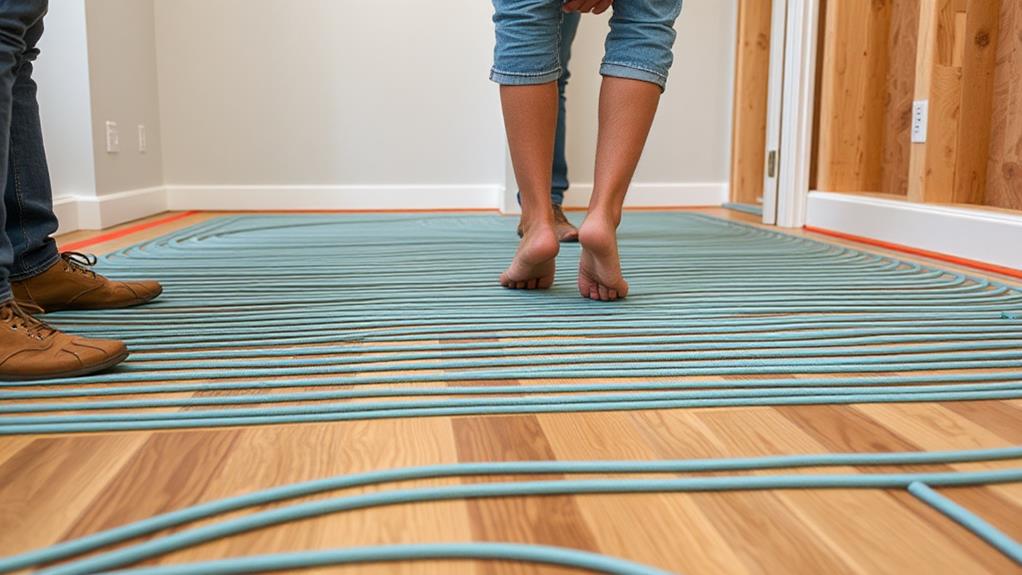
The installation process for radiant floor heating requires careful planning and consideration. You'll need to decide between hydronic (water-based) or electric systems, each with its own installation requirements.
For hydronic systems, you'll install a network of pipes beneath your flooring, connected to a boiler or water heater. Electric systems involve laying heating cables or mats under the floor.
Before installation, ensure your subfloor is level and structurally sound. You'll need to factor in floor height changes, as radiant systems can raise your floor by up to an inch. Consider the type of flooring you'll use, as some materials conduct heat better than others. Tile and stone are excellent choices, while hardwood requires careful selection to avoid warping.
You'll also need to plan for proper insulation to prevent heat loss and improve efficiency. Don't forget to account for furniture placement, as heavy items can interfere with heat distribution. It's crucial to hire a qualified professional for installation, as they'll ensure proper sizing, layout, and integration with your home's existing heating system. They'll also handle any necessary electrical or plumbing work to meet local building codes.
Maintenance and Longevity
While radiant floor heating systems are known for their durability, proper maintenance is key to ensuring their longevity. You'll find that these systems require minimal upkeep compared to traditional heating methods. However, there are a few essential tasks you should perform regularly.
First, check your system's pressure annually. If it's too low, you may need to add water to the system. It's also crucial to bleed the system of any air bubbles that might've accumulated, as these can reduce efficiency. You should inspect visible pipes and connections for signs of leaks or corrosion.
For electric systems, ensure that the thermostat is functioning correctly and replace batteries if necessary. In hydronic systems, have a professional service the boiler or water heater every few years. It's wise to keep the floor temperature consistent and avoid sudden, extreme changes, as these can stress the system.
With proper care, your radiant floor heating system can last 20 to 35 years or more. If you notice any sudden changes in performance or unexplained increases in energy bills, consult a professional promptly to address potential issues before they escalate.
Compatibility With Flooring Materials
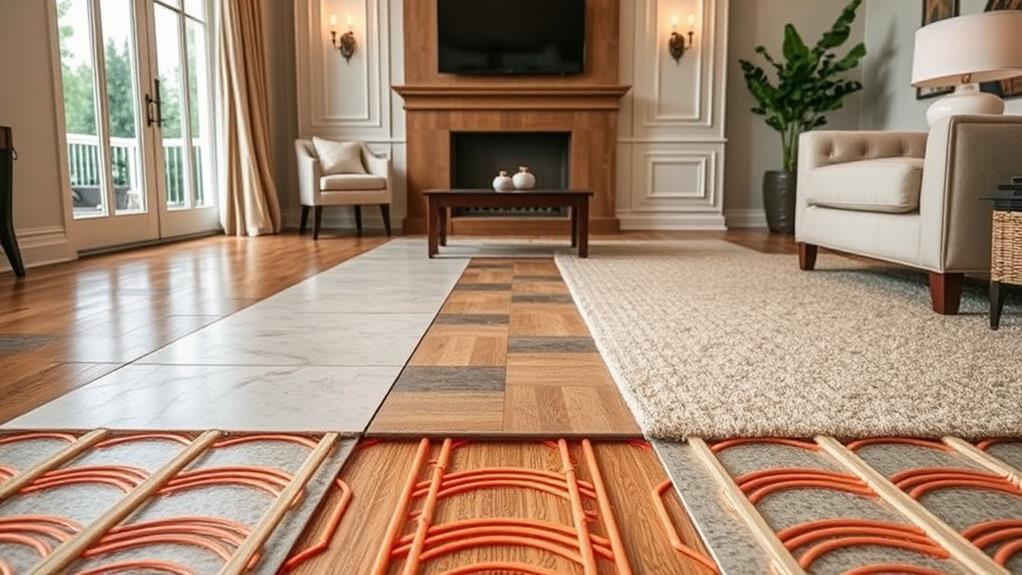
When considering radiant floor heating, it's crucial to understand its compatibility with various flooring materials. You'll find that most flooring types work well with radiant heating, but some are more efficient than others.
Tile, stone, and concrete are excellent conductors of heat, making them ideal choices for radiant floor systems. They'll transfer heat quickly and evenly, maximizing the system's efficiency.
Hardwood floors can also be used, but you'll need to take precautions. Engineered wood is generally more stable than solid hardwood, which may warp or shrink due to temperature fluctuations. If you opt for hardwood, choose thinner planks and install a moisture barrier.
Carpet can work with radiant heating, but it'll reduce heat transfer efficiency. Choose low-pile carpets with thin padding for better results. Vinyl and laminate flooring are compatible but may require temperature limitations to prevent damage. Cork flooring is a good insulator and can work well, but ensure it's properly sealed to prevent moisture issues.
Always consult with flooring manufacturers and radiant heating experts to ensure compatibility and proper installation. They'll help you select the best flooring option for your specific radiant heating system and home requirements.
Environmental Impact and Sustainability
As we shift our focus from flooring compatibility to broader considerations, it's important to examine the environmental impact and sustainability of radiant floor heating systems. These systems offer several eco-friendly advantages over traditional heating methods.
Radiant floor heating is highly energy-efficient, using lower water temperatures than conventional radiators. This efficiency translates to reduced energy consumption and lower carbon emissions. You'll also find that these systems distribute heat evenly, eliminating cold spots and reducing the need to overheat certain areas.
Many radiant systems can be powered by renewable energy sources like solar or geothermal, further decreasing their environmental footprint. The absence of ductwork in these systems means less heat loss and improved indoor air quality, as there's no circulation of dust or allergens.
When considering materials, options like electric mats made from recycled materials are available. For hydronic systems, you can choose eco-friendly piping materials such as PEX, which has a long lifespan and is recyclable.
Lastly, the longevity of radiant floor heating systems reduces the need for frequent replacements, minimizing waste and resource consumption over time.
Conclusion
You've discovered the delightful details of radiant floor heating. From cozy comfort to considerable cost savings, this system's stellar attributes are sure to satisfy. As you contemplate your next home improvement, consider the countless benefits of this cutting-edge technology. Whether you're renovating or building from scratch, radiant heating can revolutionize your residence. Embrace the efficiency, relish the relaxation, and enjoy the enduring elegance of warm floors beneath your feet.
